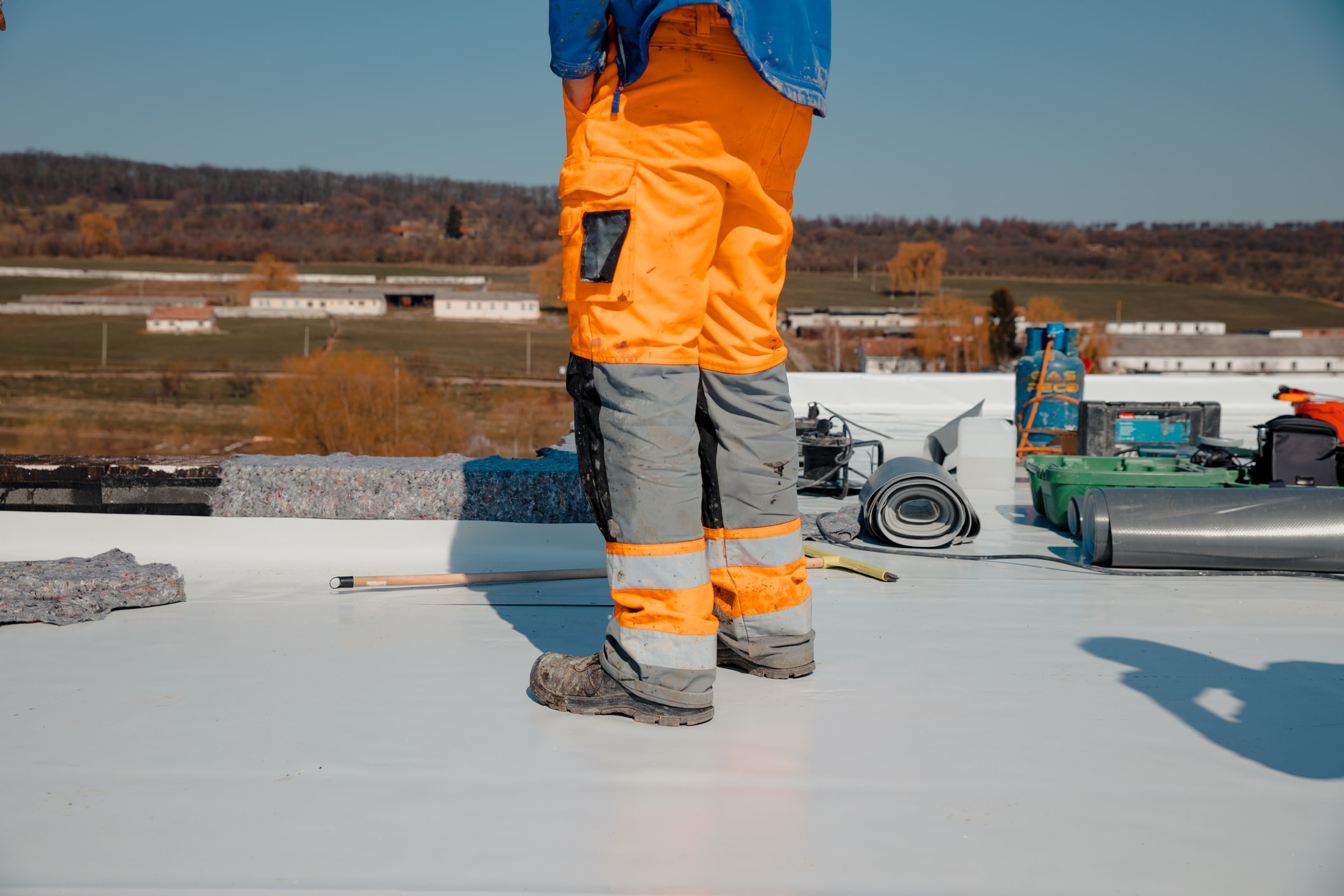Roofing is a critical aspect of any building. It protects the structure from the elements and contributes to its overall aesthetic appeal.
One roofing system that has gained popularity in recent years is TPO roofing. But what is a TPO roof?
TPO stands for Thermoplastic Polyolefin. It’s a single-ply roofing membrane known for its heat-reflective properties and energy efficiency.
Whether you’re a homeowner, business owner, or a contractor, this guide will equip you with the knowledge you need.
By the end, you’ll be able to make informed decisions about TPO roofing and communicate its complexities with ease. Let’s get started.
What Is A TPO Roof?
A TPO roof is crafted from Thermoplastic Polyolefin, a type of single-ply roofing membrane. This material is primarily used in flat roofing applications.
TPO roofing is favored for its energy efficiency. The membrane reflects sunlight, reducing heat accumulation in the building. This helps cut down on cooling costs, making it a cost-effective roofing solution.
The membrane’s composition provides excellent durability. It withstands the damaging effects of ultraviolet rays, ozone, and chemical exposure. These properties make TPO roofing a robust choice for various climates.
It’s particularly popular in commercial and industrial buildings due to its adaptability and performance. The material is lightweight, reducing the load on the building’s structure.
TPO comes in large rolls, minimizing seams when installed. Fewer seams mean fewer potential leak points, enhancing the roof’s water resistance. These attributes contribute to TPO roofing’s growing popularity.
The Composition of TPO Roofing
TPO roofing consists of three critical layers. The top layer is made from thermoplastic polyolefin, offering protection and solar reflectivity.
Beneath this is a reinforcing scrim for strength. This layer supports the membrane’s resistance to punctures and tears. Finally, another layer of TPO material forms the base.
The combination of these layers provides remarkable durability and flexibility. The formulation allows the membrane to respond well to building movement. This composition ensures that TPO roofing can handle temperature fluctuations effectively.
Installation Methods for TPO Roofing
TPO roofing can be installed using different methods. Each method affects performance and cost considerations.
One common approach is full adhesion. Adhesives are used to secure the membrane, offering strong wind resistance.
Another method is mechanical fastening. This involves securing the membrane with plates and fasteners. It’s a cost-effective and quicker installation method.
Lastly, ballasted installation uses the membrane’s weight and added ballast to hold it in place. Choosing the right method depends on specific building needs and budget constraints. Each method has its own advantages, influencing the overall roof performance.
Key Features of TPO Roofing
TPO roofing brings a wealth of advantages, making it a standout choice in the roofing industry. These features deliver significant benefits for both residential and commercial applications.
First and foremost, TPO roofing’s energy efficiency is noteworthy. Its reflective surface efficiently deflects solar heat, reducing air conditioning expenses. This makes it an attractive option for energy-conscious building owners.
The material offers excellent resistance to environmental elements. TPO withstands UV rays, ozone, and various chemicals, extending the roof’s lifespan. This durability lessens maintenance needs, a boon for building owners.
TPO’s flexibility adds to its list of attributes. It adapts well to temperature variations and settles gracefully with the building’s movements. This adaptability makes it suitable for diverse climates.
Notably, TPO roofing is available in various thicknesses and colors. This customization aids in meeting specific aesthetic and performance goals.
- Heat-reflective and energy-efficient
- Durable against UV, ozone, and chemicals
- Adaptable to building movement
- Customizable in thickness and color
- Environmentally friendly and recyclable
Energy Efficiency and Environmental Impact
TPO roofing’s energy efficiency is a principal selling point. Its white or light-colored surface reflects sunlight, lessening thermal gain. Consequently, it helps maintain lower indoor temperatures.
This reflective nature results in significant savings on cooling costs. Homeowners and businesses alike benefit financially from reduced energy consumption. Such efficiency also contributes favorably to a building’s environmental footprint.
Moreover, TPO is an environmentally responsible choice. It’s recyclable, lowering its impact on landfills at the end of its life cycle. This sustainability aspect is increasingly attractive in today’s eco-conscious society.
Durability and Performance
Durability is a critical factor in TPO roofing’s appeal. Its robust composition enables it to endure harsh elements with ease. Resistance to UV radiation, along with ozone and chemical exposure, ensures its longevity.
The performance of TPO roofing in adverse weather conditions is remarkable. It maintains integrity under high winds, offering substantial protection. This trait makes it an excellent fit for areas prone to inclement weather.
Additionally, TPO’s seams are heat-welded, strengthening them beyond mere adhesion. This process results in a watertight bond, enhancing leak prevention. Such high performance is why TPO continues to gain traction in the roofing industry.
Benefits of TPO Roofing
TPO roofing is a versatile solution for both homeowners and contractors. Its appealing benefits simplify decision-making for those selecting a roofing system.
Business owners enjoy TPO roofing’s energy efficiency, which translates into cost savings. These savings accumulate as energy bills decrease throughout the roof’s lifespan.
Contractors appreciate the ease of TPO installation. The straightforward process often results in quicker project completion, allowing for more efficient scheduling and planning.
Below are several key benefits TPO offers:
- Enhanced energy efficiency with cost savings
- Straightforward and quicker installation
- Long-lasting durability and minimal upkeep
TPO’s adaptability to various climates and building needs further highlights its all-around effectiveness. This makes it an appealing choice for a wide array of roofing projects.
Cost-Effectiveness of TPO Roofing
When it comes to cost, TPO roofing provides a valuable balance. It boasts a competitive pricing structure compared to other roofing materials. This affordability doesn’t sacrifice quality, offering robust performance at a reasonable price point.
Long-term savings are another advantage. TPO’s energy-efficient nature leads to reduced utility bills, an ongoing financial benefit. Over time, these savings can significantly offset the initial installation costs, making TPO an economical option.
Additionally, lower maintenance expenses enhance its cost-effectiveness. Minimal upkeep requirements mean fewer repairs and associated costs. This reliability ensures that TPO roofing remains a smart investment, providing substantial returns over its service life.
TPO Roofing Compared to Other Single-Ply Systems
TPO roofing stands out among single-ply systems, offering a blend of performance and affordability. Its popularity is attributed to its energy efficiency, which rivals most alternatives.
When compared to EPDM, a common single-ply option, TPO offers superior UV resistance. This quality can lead to enhanced longevity in sunny climates.
Another comparison involves PVC roofing, known for durability. TPO aligns closely with PVC in many performance aspects, often at a lower price point. This makes it a strategic choice for budget-conscious projects.
TPO vs. EPDM
TPO and EPDM are popular due to their distinct benefits. TPO’s UV resistance surpasses EPDM, especially in sunny regions. EPDM’s major strength is its flexibility. This trait is beneficial in regions with extreme temperature swings, allowing it to adapt well to such conditions.
TPO vs. PVC
Comparing TPO with PVC reveals some similarities. Both offer robust durability and energy efficiency, though PVC tends to be more costly. For contractors weighing cost against performance, TPO often presents an optimal balance between these two factors, making it an attractive option.
Maintaining Your TPO Roof
Proper maintenance is key to ensuring the longevity of your TPO roof. Routine inspections can help identify and address potential issues before they become major problems.
Cleaning the roof surface is equally important, as debris can accumulate and hinder performance. Simple upkeep can extend your roof’s lifespan significantly, maximizing your investment.
Conclusion: Is TPO Roofing Right for You?
TPO roofing offers numerous benefits, including energy efficiency and affordability. Its durable nature makes it a solid choice for many.
However, deciding if it’s right for you depends on your specific needs and circumstances. Consulting with a roofing professional can provide valuable insights tailored to your situation.





